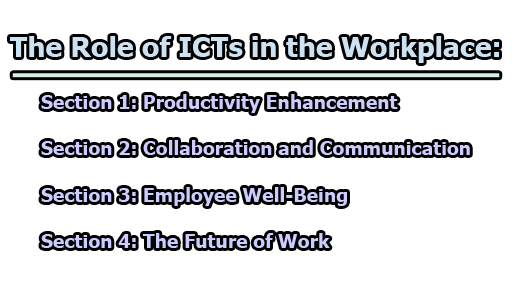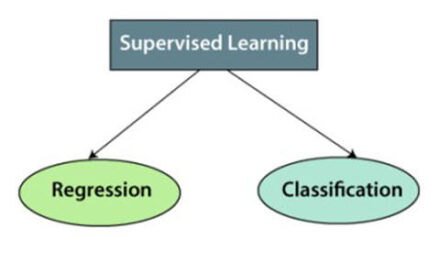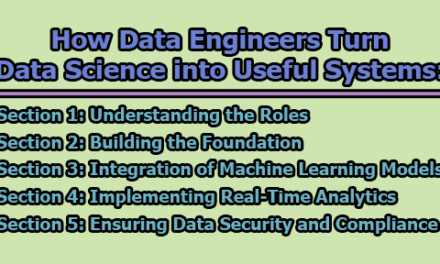The Role of ICTs in the Workplace:
The workplace is evolving rapidly, driven by advancements in Information and Communication Technologies (ICTs). These technologies encompass a wide array of tools and systems, including computers, software, mobile devices, the Internet, and communication networks. ICTs have not only revolutionized the way businesses operate but have also transformed the nature of work itself. This article explores the multifaceted role of ICTs in the workplace, focusing on their impact on productivity, collaboration, communication, employee well-being, and the future of work.
Section 1: Productivity Enhancement:
1.1 Automation and Efficiency: ICTs have streamlined and automated many tasks that were once time-consuming and manual. With the advent of software applications and artificial intelligence, routine and repetitive tasks can be performed more quickly and accurately. This has led to increased productivity as employees can dedicate more time to value-added activities, such as problem-solving, creativity, and innovation.
1.2 Remote Work: One of the most significant shifts driven by ICTs is the rise of remote work. The COVID-19 pandemic accelerated this trend, forcing businesses to adapt to remote work environments. Technologies such as video conferencing, cloud computing, and project management software have made it possible for employees to work from anywhere with an internet connection. This flexibility not only enhances productivity but also offers employees a better work-life balance.
1.3 Data Analytics: ICTs have enabled organizations to collect and analyze vast amounts of data. Through data analytics tools, businesses can gain valuable insights into customer behavior, market trends, and operational efficiency. This data-driven decision-making process allows for more informed and strategic choices, ultimately improving productivity and competitiveness.
1.4 Streamlined Workflow: ICTs play a crucial role in streamlining workflow processes within organizations. Workflow automation tools allow businesses to design and automate complex workflows, ensuring that tasks are completed in a structured and efficient manner. This reduces the chances of bottlenecks and delays, further enhancing overall productivity.
1.5 Enhanced Project Management: Project management software, often integrated with ICTs, provides organizations with the tools needed to plan, execute, and monitor projects effectively. These platforms enable teams to collaborate, track progress, and allocate resources efficiently, leading to improved project outcomes and productivity gains.
1.6 Personalized and Adaptive Learning: Incorporating ICTs in employee training and development can significantly boost productivity. Personalized e-learning platforms utilize algorithms and data analytics to tailor learning materials to individual needs. This ensures that employees acquire the specific skills and knowledge required for their roles, enhancing their efficiency and effectiveness on the job.
1.7 Time Tracking and Management: ICTs offer various time-tracking and management tools that help employees manage their work hours more efficiently. These tools can help identify time-wasting activities, track billable hours for clients or projects, and provide insights into how time is allocated. By improving time management, employees can prioritize tasks effectively and increase their overall productivity.
1.8 Supply Chain Optimization: For businesses involved in manufacturing or distribution, ICTs have transformed supply chain management. Advanced software and data analytics allow organizations to optimize inventory levels, predict demand, and streamline logistics. This not only reduces costs but also ensures that products are delivered more efficiently, contributing to higher productivity.
1.9 Virtual Assistants and Chatbots: The integration of virtual assistants and chatbots into the workplace can automate routine administrative tasks. These AI-powered tools can handle inquiries, schedule appointments, and provide information, freeing up employees to focus on higher-value tasks. Virtual assistants enhance efficiency by providing quick and accurate responses, thus reducing response times and improving customer service.
1.10 Enhanced Decision Support Systems: Decision support systems powered by ICTs can help organizations make more informed decisions. These systems analyze data from various sources, enabling executives to identify trends, opportunities, and potential risks. By providing decision-makers with timely and relevant information, ICTs contribute to better decision-making and, subsequently, increased productivity.
1.11 Improved Customer Relationship Management (CRM): CRM software, a key component of ICTs, enables organizations to manage customer interactions more effectively. By centralizing customer data and automating processes, businesses can provide more personalized services, anticipate customer needs, and streamline sales and marketing efforts. This not only enhances customer satisfaction but also boosts sales and revenue, contributing to overall productivity.
Section 2: Collaboration and Communication:
2.1 Virtual Teams: Globalization and ICTs have made it easier for organizations to collaborate with partners and employees worldwide. Virtual teams, composed of members from different geographical locations, can work together seamlessly through video conferencing, instant messaging, and collaborative software. This has expanded the talent pool and fostered diversity in the workplace.
2.2 Communication Tools: The proliferation of communication tools like email, instant messaging, and social media platforms has revolutionized internal and external communication. Real-time communication allows employees to stay connected, share information, and collaborate effectively, regardless of physical distance. However, managing communication overload and ensuring effective communication remain challenges.
2.3 Knowledge Sharing: ICTs have facilitated knowledge sharing within organizations. Intranet portals, wikis, and document management systems enable employees to access and contribute to a collective pool of knowledge. This not only promotes learning and innovation but also ensures that information is readily available to support decision-making.
2.4 Video Conferencing Enhancements: Video conferencing technologies have evolved significantly, offering features like high-definition video quality, screen sharing, and virtual backgrounds. These enhancements enable more immersive and productive virtual meetings, making it easier for teams to collaborate, share ideas, and make decisions in real-time.
2.5 Project Collaboration Platforms: Collaborative project management platforms, such as Microsoft Teams, Slack, and Trello, have gained popularity in the workplace. These tools integrate various communication channels, task management, and file sharing capabilities into a single platform. They promote transparency, streamline workflows, and facilitate efficient project collaboration among team members.
2.6 Cloud-Based Collaboration: Cloud computing has enabled real-time collaboration on documents and files from anywhere with an internet connection. Tools like Google Workspace and Microsoft 365 allow multiple users to work on the same document simultaneously, enhancing teamwork and eliminating the need for version control.
2.7 Cross-Functional Collaboration: ICTs have made it easier for different departments within an organization to collaborate effectively. For instance, marketing teams can access sales data, and customer support teams can provide feedback directly to product development. This cross-functional collaboration leads to more informed decision-making and improved customer service.
2.8 Social Intranet and Enterprise Social Networks: Social intranet platforms and enterprise social networks provide employees with a space to share ideas, ask questions, and collaborate informally. These platforms encourage employee engagement, foster a sense of community, and facilitate knowledge sharing beyond formal channels.
2.9 Multi-Platform Integration: Many organizations use a combination of communication and collaboration tools. ICTs have evolved to offer integration solutions, ensuring that data and communication flow seamlessly between different platforms. This reduces redundancy, enhances efficiency, and prevents information silos.
2.10 Mobile Collaboration: Mobile applications and devices have expanded the possibilities for collaboration. Employees can access work-related information, communicate with colleagues, and collaborate on projects from their smartphones and tablets. This mobility enhances productivity, especially for remote and on-the-go workers.
2.11 Enhanced Security Measures: As organizations rely more on ICTs for collaboration and communication, the need for robust cybersecurity measures becomes critical. Encryption, secure authentication methods, and data loss prevention tools help protect sensitive information shared during collaborations, ensuring confidentiality and compliance with data privacy regulations.
2.12 Virtual Reality (VR) for Collaboration: Emerging technologies like virtual reality (VR) are being employed for immersive collaborative experiences. VR enables users to interact in virtual spaces, making teamwork more engaging and effective, especially for industries like architecture, design, and engineering.
2.13 Language Translation Tools: For global teams, language barriers can pose challenges. ICTs offer language translation tools that can translate written and spoken communication in real-time, making it easier for international teams to collaborate and communicate effectively.
2.14 Accessibility Features: ICTs are increasingly focusing on accessibility features to ensure that communication and collaboration tools are usable by all employees, including those with disabilities. These features enhance inclusivity and diversity in the workplace.
Section 3: Employee Well-Being:
3.1 Work-Life Balance: While ICTs have enabled remote work, they have also blurred the boundaries between work and personal life. Achieving a healthy work-life balance in an always-connected world can be challenging. Employers must establish policies and practices to mitigate burnout and support their employees’ well-being.
3.2 Health and Ergonomics: The use of ICTs for extended periods can lead to health issues, such as eye strain, musculoskeletal disorders, and mental stress. Employers must prioritize ergonomics and provide resources for maintaining physical and mental health in the digital workplace.
3.3 Training and Upskilling: To fully harness the potential of ICTs, employees need the skills and knowledge to use these technologies effectively. Employers should invest in training and upskilling programs to empower their workforce and ensure that employees can adapt to evolving technologies.
3.4 Digital Detox Initiatives: To combat the negative effects of constant connectivity, some organizations are implementing digital detox initiatives. These programs encourage employees to take regular breaks from digital devices, email, and work-related communication to recharge and reduce stress.
3.5 Flexible Work Arrangements: ICTs enable flexible work arrangements, allowing employees to adjust their schedules to better suit their personal needs. This flexibility not only contributes to a better work-life balance but also helps employees manage their well-being by accommodating personal commitments and avoiding commuting-related stress.
3.6 Mental Health Support: The digital workplace can be mentally taxing, leading to stress and burnout. Employers are increasingly recognizing the importance of mental health support programs. These may include access to counseling services, stress management workshops, and initiatives aimed at reducing the stigma surrounding mental health issues.
3.7 Ergonomic Workstations: Employers can invest in ergonomic workstations to reduce the physical strain caused by prolonged ICT usage. Adjustable chairs, ergonomic keyboards, standing desks, and monitor risers can help employees maintain better posture and reduce the risk of musculoskeletal disorders.
3.8 Wellness Apps and Wearables: Wellness apps and wearable devices, such as fitness trackers and mindfulness apps, can encourage employees to prioritize their physical and mental health. Employers can support the use of these tools by providing subsidies or incentives for employees to adopt healthy habits.
3.9 Cybersecurity Awareness Training: To reduce stress related to cybersecurity threats and data breaches, organizations can offer cybersecurity awareness training. This empowers employees to recognize and respond to potential security risks, reducing anxiety and enhancing their sense of security in the digital workplace.
3.10 Job Rotation and Skill Diversification: Repetitive tasks and constant reliance on ICTs can lead to monotony and reduced job satisfaction. Employers can introduce job rotation programs, allowing employees to diversify their skills and tasks. This not only enhances job satisfaction but also promotes continuous learning and personal growth.
3.11 Workload Management: ICTs can sometimes result in an “always-on” culture where employees feel pressured to be constantly available. Employers must establish workload management strategies that prevent employees from being overwhelmed with excessive demands, reducing stress and promoting well-being.
3.12 Employee Feedback and Involvement: Listening to employee feedback and involving them in decision-making regarding ICT implementation and workplace policies can contribute to a healthier work environment. Employees who feel heard and valued are more likely to have a positive work experience and better overall well-being.
3.13 Supportive Leadership: Leadership plays a critical role in fostering a culture of well-being in the digital workplace. Supportive leaders provide guidance, recognize achievements, and prioritize employee well-being. They set an example by maintaining their own work-life balance and promoting a healthy work culture.
Section 4: The Future of Work:
4.1 Artificial Intelligence and Automation: The future of work is closely tied to the continued development of artificial intelligence (AI) and automation technologies. As AI becomes more sophisticated, it will handle increasingly complex tasks, potentially reshaping job roles and industries. Organizations must adapt by reskilling their workforce and rethinking their business models.
4.2 Gig Economy and Flexibility: ICTs have facilitated the rise of the gig economy, where workers engage in short-term, project-based work arrangements. Platforms and apps connect freelancers with employers, offering flexibility for both parties. This trend raises questions about job security, benefits, and the need for regulations to protect workers’ rights.
4.3 Cybersecurity and Data Privacy: As organizations rely more heavily on ICTs, the importance of cybersecurity and data privacy becomes paramount. Protecting sensitive information from cyberattacks and ensuring compliance with data protection regulations are ongoing challenges. Employers must invest in robust cybersecurity measures and educate their workforce on best practices.
4.4 Augmented and Virtual Reality: Emerging technologies like augmented reality (AR) and virtual reality (VR) are poised to transform the workplace further. These technologies can enhance training, simulation, and remote collaboration, creating new possibilities for industries such as healthcare, education, and manufacturing.
4.5 Remote Work Evolution: The future of work is likely to see the continued evolution of remote work. Advances in ICTs will enable more immersive and effective remote collaboration, blurring the lines between in-person and virtual workspaces. Virtual reality (VR) and augmented reality (AR) technologies, for example, will create realistic virtual meeting spaces, making remote work feel more like traditional office interactions.
4.6 Blockchain in the Workplace: Blockchain technology has the potential to revolutionize various aspects of work, particularly in areas like supply chain management, contract execution, and data security. Blockchain can provide transparency, traceability, and trust in transactions, reducing the need for intermediaries and streamlining business processes.
4.7 AI-Powered Personalization: Artificial intelligence and machine learning will further personalize the workplace experience. AI-driven systems can adapt to individual preferences, providing tailored recommendations for tasks, communication, and learning. This personalization enhances employee satisfaction and productivity.
4.8 Ethical AI and Bias Mitigation: As AI becomes more prominent, addressing issues of bias and ethics in AI algorithms will become increasingly important. Organizations will need to invest in ethical AI development and training to ensure fair and unbiased decision-making processes.
4.9 Human-AI Collaboration: The future of work will likely involve deeper collaboration between humans and AI. AI can handle routine tasks, data analysis, and process automation, while humans contribute creativity, critical thinking, and emotional intelligence. Organizations will need to create environments that facilitate seamless human-AI collaboration.
4.10 Data Governance and Regulation: With the increasing reliance on data, there will be a growing focus on data governance and regulation. Organizations must ensure compliance with evolving data protection laws and privacy regulations, such as GDPR and CCPA. This will require ongoing investment in data security and privacy measures.
4.11 Skills-Based Hiring and Gig Economy Integration: Employers may shift their focus from traditional credentials to skills-based hiring. The gig economy’s integration into the broader workforce will require a flexible approach to talent acquisition, with a focus on matching individuals’ skills with specific project needs rather than traditional job titles.
4.12 Workplace Health and Well-being Technologies: The future workplace may incorporate technologies designed to monitor and improve employee health and well-being. Wearable devices, health-tracking apps, and AI-powered tools can help employees manage stress, maintain physical health, and achieve a better work-life balance.
4.13 Environmental Sustainability: ICTs will play a role in achieving greater environmental sustainability in the workplace. Virtual meetings and remote work can reduce the need for physical office space and commuting, contributing to reduced carbon footprints. Additionally, IoT devices can monitor and optimize energy usage in office buildings.
4.14 Global Collaboration and Diversity: ICTs will continue to facilitate global collaboration, bringing together diverse teams from different regions and backgrounds. This diversity can foster creativity and innovation, but it also requires organizations to adopt inclusive practices and cultural sensitivity.
In conclusion, Information and Communication Technologies have become integral to the modern workplace, profoundly influencing productivity, collaboration, communication, and employee well-being. As we look ahead, the future of work will continue to be shaped by ICTs, with AI, automation, and emerging technologies playing pivotal roles. Employers must adapt to these changes, prioritizing the well-being and upskilling of their workforce while addressing the challenges posed by cybersecurity and the gig economy. In this dynamic landscape, embracing ICTs as a means to enhance the workplace experience is not just an option but a necessity for organizations seeking to thrive in the digital age.

Assistant Teacher at Zinzira Pir Mohammad Pilot School and College










